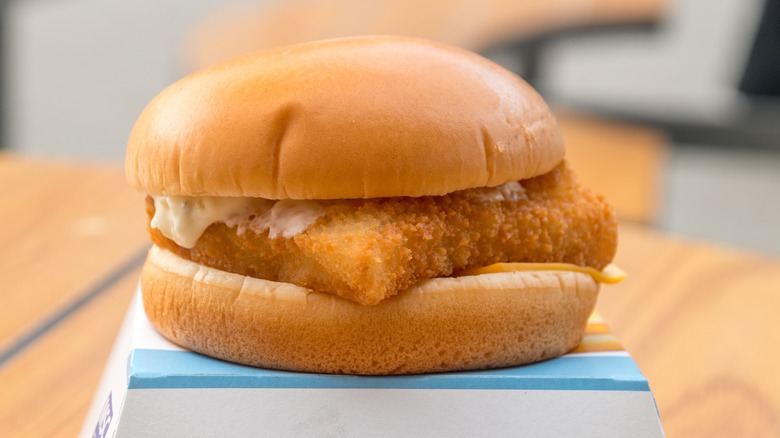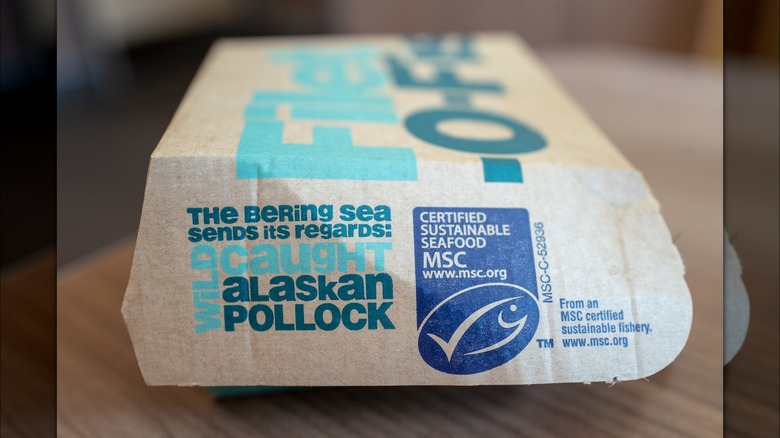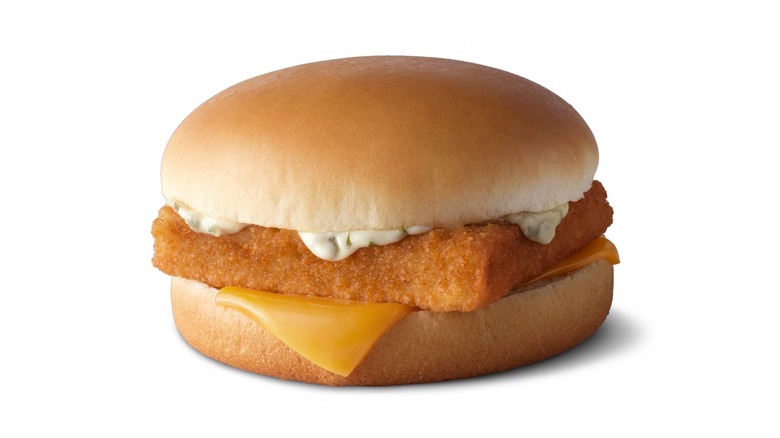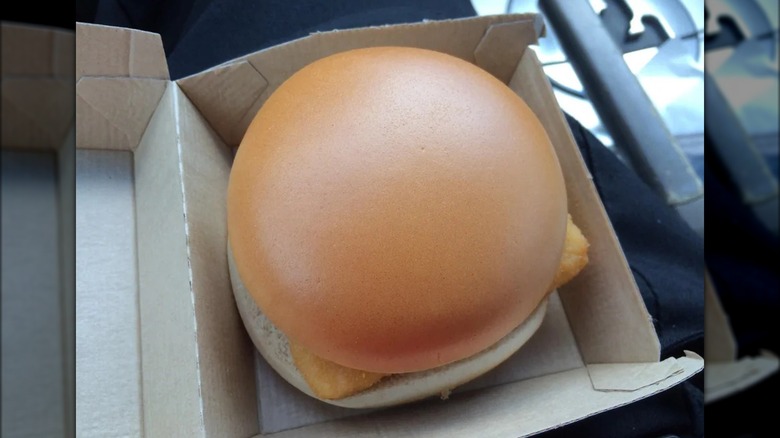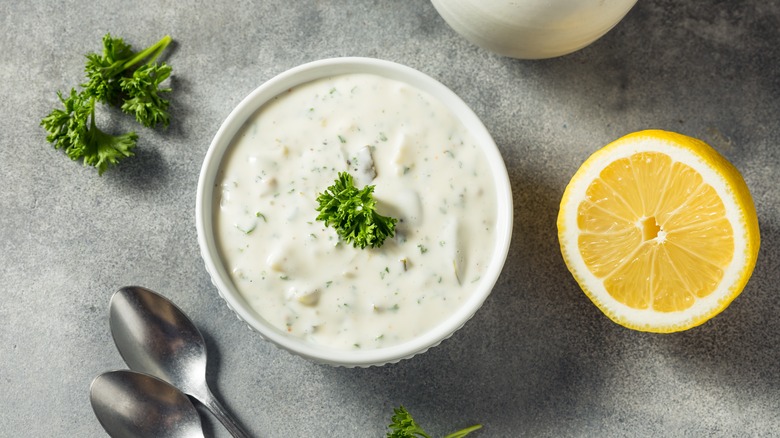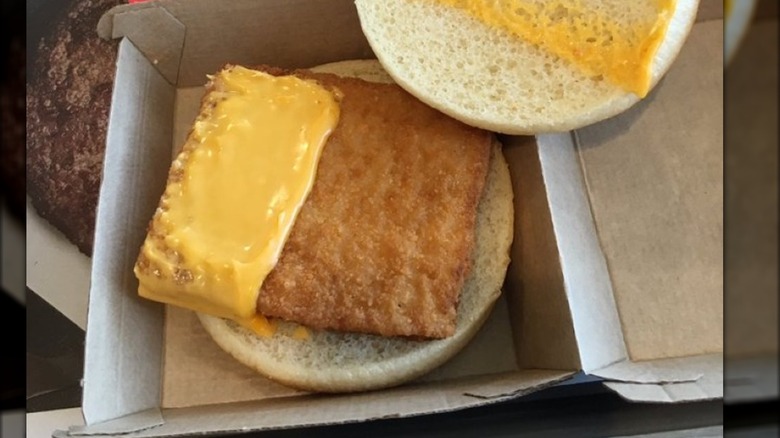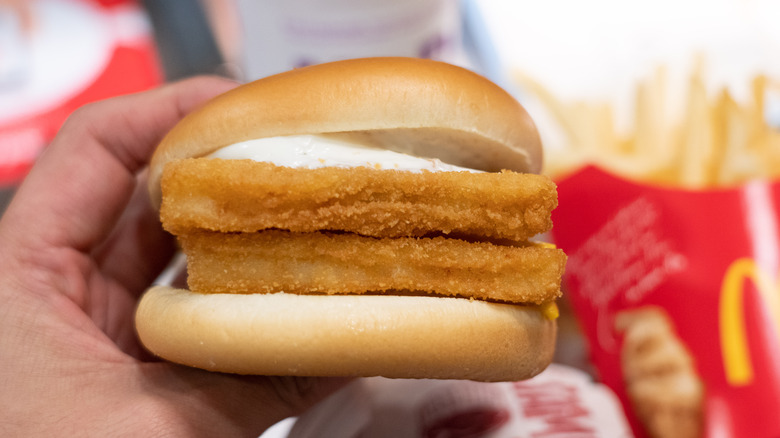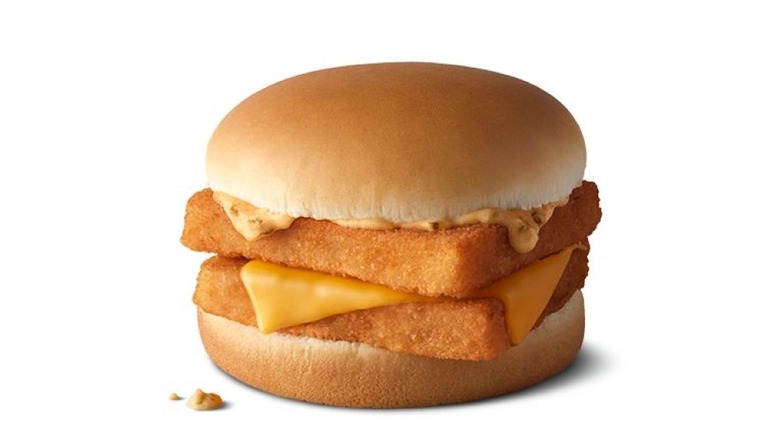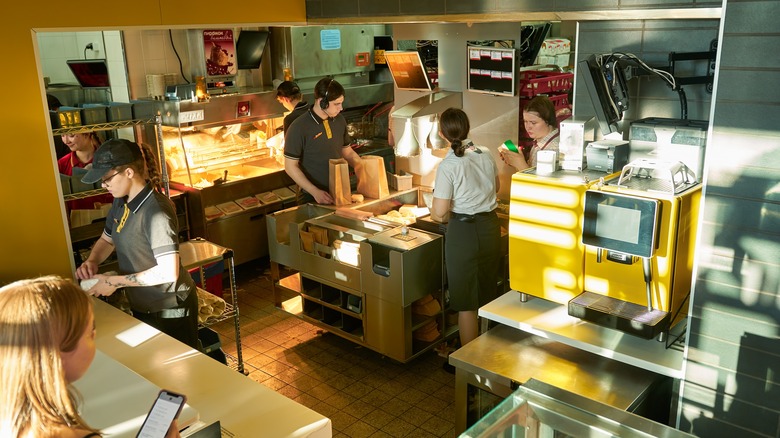12 Facts About McDonald's Filet-O-Fish That Are Finally Out In The Open
The McDonald's Filet-O-Fish might not be as iconic as the Big Mac is, but it's actually been around longer. It first debuted in 1962 and has become a renowned staple on McDonald's menus across the globe. The New York Times once called the Filet-O-Fish "the gold standard of fast food." And in a CNN interview, Donald Trump named it one of his favorite McDonald's items to order. With just a filet, a half slice of cheese, and tartar sauce all on a bun, it's simple yet reliable.
But beyond the sandwich's basic ingredients, you probably don't know much about this famous McDonald's item. Luckily, we went on a fishing expedition to uncover some fun facts and little-known secrets. Don't worry though, there's nothing too fishy about this McDonald's meal — besides the Alaskan pollock, of course. So if we caught your attention, prepare to learn something new about the Filet-O-Fish.
1. McDonald's Filet-O-Fish has religious roots
A little-known fact about the Filet-O-Fish is that it was born in 1960s Cincinnati. This might strike some as odd, seeing that Ohio doesn't have a coastline and isn't exactly known for its seafood. However, the local cuisine wasn't a factor. Instead, it was the local religion that spurred on this sandwich.
It all started with Lou Groen, the owner of Cincinnati's first McDonald's franchise. He quickly noticed sales plummeted on Fridays because its clientele didn't consume meat. While this is common during Lent, some devout Catholics abstain from meat every Friday year-round. And up until 1966, official Catholic Church law actually prohibited it. With a high Catholic population, Cincinnatians were paying penance rather than paying for burgers.
In 1962, Lou Groen took matters into his own hands by coming up with a meatless replacement for the burger. In an interview with USA Today, Groen explained: "I invented my fish sandwich, developed a special batter, made the tartar sauce, and took it to headquarters ... My fish sandwich was the first addition ever to McDonald's original menu. It saved my franchise."
Church doctrine changed in 1983, and it only forbade meat consumption on Fridays during Lent. But by that time, the Filet-O-Fish had become a sensation. Although you might still see sales soar during Lent, today, this sandwich is loved year-round — and not just by the Catholic community.
2. The Filet-O-Fish battled it out against the Hula Burger
When the Filet-O-Fish first came on the scene, it didn't immediately win over everyone's hearts at corporate. McDonald's founder Ray Kroc initially opposed the idea and had a completely different sandwich in mind. Kroc had developed the Hula Burger, consisting of a grilled pineapple ring sandwiched between cheese slices and a bun. He felt McDonald's only needed one meatless sandwich on the menu, so Groen and Kroc battled it out.
The two released their meatless burgers on a designated Friday to compete for sales. McDonald's reports that the Filet-O-Fish won by a landslide, with 350 sales to the Hula Burger's measly six. It was obvious who won the popularity contest, and the Filet-O-Fish was formally added to the menu in 1965. The Hula Burger may have been a flop, but ingenuity has taken McDonald's a long way, and Groen's Filet-O-Fish proved an international success — and not just on fish Fridays.
3. The fish changed over the years
Fast food restaurants have a bad rap for using artificial ingredients, and people question whether McDonald's Filet-O-Fish is even real fish. We were happy to discover that McDonald's Filet-O-Fish is made with 100% wild-caught Alaskan pollock. Pollock is a type of cod, a white fish with flaky meat. Compared to other cod species, Alaskan pollock tends to be softer and fattier. In this McDonald's sandwich, the fish is light and tender with a thin breaded coating that keeps the filet intact while providing a nice crunch.
However, this sandwich didn't start out with Alaskan pollock. Filet-O-Fish inventor Groen describes his initial vision: "I wanted halibut originally. I was paying $2 a pound for halibut. That sandwich cost me 30 cents apiece to make. They told me it had to sell for 25 cents. I had to fall back on Atlantic cod," according to USA Today.
In 2013, McDonald's decided to switch things up again, announcing that the company would source all of its fish from one Alaskan pollock fishery, according to The Christian Science Monitor. By sourcing from this one location, McDonald's could ensure that its fish is 100% sustainably sourced. This is a surprising yet welcomed fact in the fast food world — and next time you bite into a Filet-O-Fish, you can rest assured it's real fish from ethical sourcing.
4. The filet is square for consistency
Unlike your average hamburger patty, McDonald's Filet-O-Fish is square. But is this simply a way to distinguish it from beef burgers — or is there a deeper reason behind the filet's geometry?
On Reddit, consumers speculated that the patties were squared so they "[would] not be confused for the similarly coated, but round, veggie burger." Another user on the same thread believed the shape was created for "greater efficiency when cutting." However, McDonald's assures its guests that its fish filets are square to keep quality control. The company described the process in a Facebook post: "At sea, we layer whole Alaska Pollock fillets in a large block. Then, we slice it into squares to ensure we deliver our customers a perfect sandwich every time!"
Based on geometry alone, we'd imagine squares are easier to measure and transport with less waste. Practicality aside, its signature shape sets this sandwich apart from the competition. When we see a square filet between two circular buns, we know we're dealing with none other than McDonald's Filet-O-Fish.
5. It comes on a steamed bun
It's not just the square-shaped filet that sets this sandwich apart. The Filet-O-Fish is also the only sandwich at McDonald's that uses a steamed bun. In a viral TikTok, Essential McDonald's shows that the bun is steamed for 11 seconds before being placed in the box and topped with tartar sauce, fish, and cheese.
Even if you've never tried a Filet-O-Fish, you might recognize its bun. It's the same one used for the chain's double cheeseburgers. However, steaming the bun creates a soft, fluffy texture that consumers love. One Reddit fan agrees, describing, "The soft steamed bun is like a heavenly pillow that holds a perfectly crisp and flaky patty of sustainable Alaskan pollock."
Are you craving a steamed bun but not in the mood for fish? We've got you covered. One of our favorite McDonald's hacks is to ask for any sandwich with a steamed bun instead of the typical toasted sesame one. It's an easy alteration but ensures an even fresher sandwich with that soft, fluffy texture.
6. It has a sought-after tartar sauce
Tartar sauce gives the Filet-O-Fish some necessary creaminess and a rich, tangy taste. After all, you can't spell tartar sauce without "tart," and this flavor complements fish oh so well. However, not all tartar sauces were created equal, and McDonald's has a solid reputation in the industry. You might even say the sauce alone can reel in consumers. While it does include a few preservatives, McDonald's tartar sauce is also made with natural ingredients, including diced pickles, capers, egg yolks, and parsley.
When it comes to McDonald's tartar sauce, there are several copycat recipes out there. But if you don't want the hassle of making it yourself, you might want to get your hands on McDonald's bottled version. McDonald's gave away limited edition bottled tartar sauce in 2017. It was such a hit that the company started selling these condiments in Canada. Unfortunately, on a McDonald's subreddit, one consumer warned Canadians against purchasing this product: "[It's] not "authentic" and is nothing close to what McDonald's actually serves. Not only is it not real McDonald's sauce, but it's also very low quality and something very few people would find appetizing."
7. The half slice of cheese is intentional
If you've ever opened up your Filet-O-Fish sandwich and noticed just a half slice of cheese, you might have wondered, "Where did the rest of it go?" However, this is no mistake. Your sandwich isn't technically missing any ingredients because that half slice of cheese is intentional.
In an interview with the Journal Star, McDonald's spokeswoman Julie Caturano explained that the half slice of cheese has "always been that way. When you think of a cheeseburger, it's really cheesy. With the filet, a half slice complements the taste rather than overwhelming it."
If you're not satisfied with half a slice, just ask for extra cheese. However, many people would argue that cheese has no place on a fish sandwich anyway. The intense flavor and creaminess of cheese can easily overpower the delicate nature of seafood. Perhaps McDonald's struck the perfect balance with just half a slice.
8. The sandwich had its own mascot
Meet Phil A. O'Fish, a cute sailor-meets-fish mascot used in early advertising campaigns. This light blue cod donned a navy-colored sailor jacket and yellow hat with a fishing net in hand. He encouraged consumers to try the Filet-O-Fish "For a Surprisingly Good Taste."
It's a bit ironic that a fish was promoting consumption of his own kind, which could explain why Phil A. O'Fish was so short-lived. The only advertisements we could scrounge up using this mascot were from 1967. The following year, Phil A. O'Fish mysteriously disappeared.
You might also recall Captain Crook, who surfaced in 1971. His primary mission in life was to steal Filet-O-Fish sandwiches (much like the Hamburgler stole hamburgers). The McDonald's character was your quintessential pirate, equipped with a puffy white shirt, red jacket, and pirate hat — he even had a green parrot on his shoulder. Some may have believed he appeared too sinister, so he transformed in his later years into a friendlier-looking pirate. However, he eventually retired in the mid-80s.
9. The filet is used in a secret menu item
We all know fast food joints have secret menus. And if you're a fish fan, you might be looking for creative ways to consume McDonald's fish burgers. So, which McDonald's secret menu items use the filet? Our top contender was the Land, Sea, and Air Burger, which completely blew us away.
This burger takes surf and turf to the next level. It's also just as it sounds, with a beef patty, fish filet, and crispy chicken burger stacked on top of one another. You'll also find a slice of melted cheese, tartar sauce, pickles, ketchup, and mustard.
While it may have started as a secret menu item, this colossal creation was eventually added to the menu for a limited time only. The limited edition sandwich is a double-decker version of the one we described. It rings in at a whopping 1330 calories, and instead of ketchup and mustard, it has Big Mac sauce and mayonnaise. This challenge isn't for the faint at heart, and we'd only recommend ordering it if you're exceptionally hungry. But if curiosity has the better of you, order one while you still can.
10. Hawaiians are big Filet-O-Fish fans
McDonald's Filet-O-Fish may have started in Ohio, but today, its biggest fans are far from the Midwestern state. According to the 2022 McDonald's USA FANnual Report, Hawaii consumers ordered the most Filet-O-Fish sandwiches per capita than any other state. The runner-up was Maryland, another seaside location.
It's no surprise that people from these coastal states love seafood. An Aquaculture, Fish & Fisheries report noted that Hawaiians eat twice as much seafood as the national average. On the other side of the country, Maryland is known for its crabs and clams. Since seafood is commonplace in both states, residents are more naturally inclined to order the Filet-O-Fish — even if the fish isn't from local sources. McDonald's claims that its filets are made of 100% Alaskan pollock, a fish from the North Pacific. As such, McDonald's in Hawaii and Maryland import fish just like the rest of us. However, that doesn't stop locals from their seafood-loving ways.
11. There are twists on this fishy favorite
McDonald's is standardized across most states, so you can rely on the Filet-O-Fish to taste the same wherever you go. However, when visiting an international McDonald's, you might notice slight alterations to the Filet-O-Fish.
Instead of solely pollock fish, Ireland's McDonald's also uses white hoki. You'd have to have a very refined palate to note the difference. However, Singapore's twist on this fish sandwich isn't as subtle. Here, you'll find Wasabi Filet-O-Fish burgers that come with all the standard toppings, as well as lettuce and wasabi mayo. The wasabi is said to be both sweet and spicy with a pastel green hue.
In addition to the standard sandwich, residents of some states can order an Old Bay Filet-O-Fish. On this version, the tartar sauce has been blended with Old Bay seasoning, a mixture containing paprika and mustard, along with other spices. The Filet-O-Fish is a simple sandwich, so if you want to spice things up, go for the Old Bay filet. And if you can't get enough of this peppery-sauced sandwich, order a double.
12. McDonald's employees might advise against ordering one
When looking for the inside scoop on a fast food joint, the best people to talk to are the employees. They see exactly what happens behind the scenes, for better or worse. Unfortunately, in the case of McDonald's Filet-O-Fish, it appears to be for the worse.
On a popular Reddit thread, restaurant chain workers were asked what dishes they would avoid and why. Many immediately said fish, citing a lack of freshness. Luckily, one user on the same thread had a clever workaround: "At McDonald's, just say you want a fish filet cooked to order. It will take ~5 more minutes but worth it compared to the filet that has been in the heated cabinet for hours."
If you're skeptical of whether or not the staff will honor that "cooked to order" request, ask for a modification. Ordering a Filet-O-Fish with no cheese or extra cheese forces the restaurant staff to cook it on the spot.
